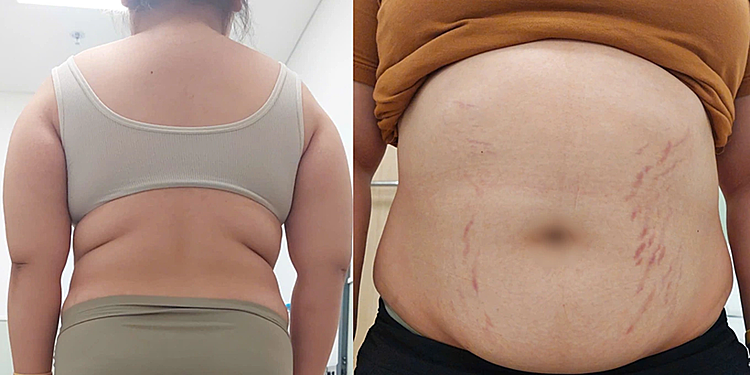On 15/9, Hong Ngoc General Hospital reported a young patient admitted with several physical abnormalities: a rounded face, broad shoulders, a fatty hump on the back of her neck, facial hair, and stretch marks on her abdomen and thighs. The family had tried various methods, including dietary changes, exercise, and treatments at multiple facilities, but saw no improvement. The patient was also diagnosed with high blood pressure, reduced bone density (early-onset osteoporosis), kidney stones, and hydronephrosis – conditions typically seen in middle age.
 |
The patient gained 20 kg, developed broad shoulders, a buffalo hump, and red stretch marks on her abdomen and thighs. Photo: Hospital provided |
The patient gained 20 kg, developed broad shoulders, a buffalo hump, and red stretch marks on her abdomen and thighs. Photo: Hospital provided
Doctor Kieu Hong Nhung from the Endocrinology Department, who directly treated the patient, said these were typical signs of Cushing's syndrome. This occurs when the body has too much cortisol, either from external sources or produced internally. Cortisol, a steroid hormone also known as the stress hormone, is released by the body during times of stress, leading to increased heart rate, blood pressure, blood sugar, and muscle tension. However, CT and MRI scans of the pituitary and adrenal glands were normal, making it difficult to determine the root cause.
Doctors had to take blood samples directly from both adrenal glands to measure cortisol levels. The results confirmed the patient had Cushing's syndrome, specifically primary pigmented nodular adrenocortical disease (PPNAD).
PPNAD is characterized by the presence of multiple small, dark-pigmented nodules. These nodules independently produce cortisol, unregulated by hormones from the pituitary gland, leading to chronic cortisol excess. According to international medical literature, PPNAD accounts for only about 1% of all Cushing's syndrome cases.
Doctors recognized that if only the symptoms were treated without addressing the underlying cause, the patient could face life-threatening complications if not promptly addressed. These include infections, venous thromboembolism in the lungs and legs, depression, heart attack, weight gain, memory problems, difficulty concentrating, high blood pressure, high cholesterol, bone fractures, type 2 diabetes, and even death.
The surgical team performed a laparoscopic bilateral adrenalectomy to completely remove the source of the prolonged cortisol excess. After one month, the patient lost 3 kg, and her bone, joint, and muscle pain significantly improved, allowing her to participate in high-intensity physical activities like swimming and badminton.
With strict adherence to a long-term treatment plan, combined with a proper diet and regular lifestyle, the patient can regain her normal physique, achieve hormonal balance, have regular menstrual cycles, and develop healthily like other children her age, the doctor said.
Thuy Quynh












